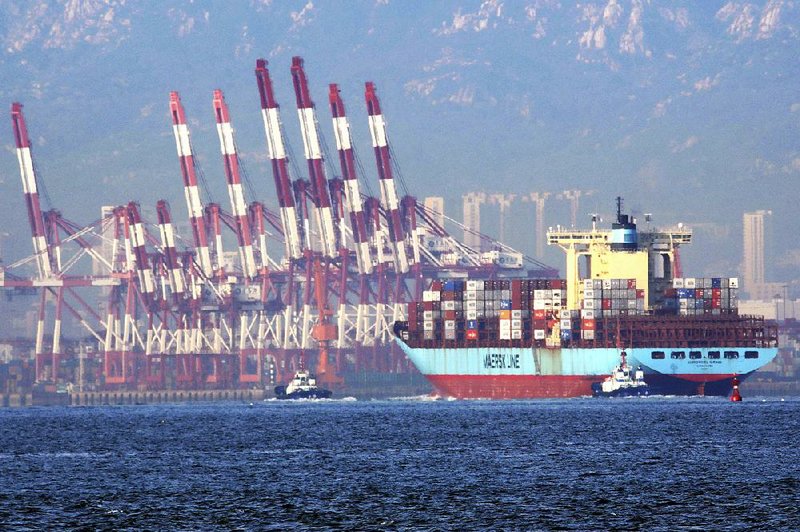BEIJING -- China's trade surplus with the United States hit a record last month, defying -- for now, at least -- President Donald Trump's predictions that tariffs would help redress the trade imbalance.
Although economists expect the American tariffs to eventually have an impact, the trade statistics reinforce the widely held notion in China that there will be no quick end to the trade war between Washington and Beijing.
"It's obvious that the immediate effects of the trade war are the exact opposite of what the Trump administration had been planning," said Andrew Polk of Trivium China, a Beijing-based economics research firm.
"We expect the dynamic to change once we get a bit deeper into this, but for now China is trying to outrun the next round of tariffs," he said.
China enjoyed a record high $34.1 billion trade surplus with the U.S. in September, taking the surplus for the year to date to $225.8 billion, according to Chinese statistics released on Friday. That's significantly higher than the $196 billion recorded between January and September last year.
The increase, the result of both increasing exports from China to the U.S. -- up 14.5 percent from the same month last year -- and a decline in the goods that China is buying from the U.S.
The worsening trade imbalance is also a reflection of the two countries' economies, experts said. The U.S. economy is strengthening, with unemployment low and growth increasing, while the Chinese economy is slowing, sapping Chinese consumers' ability to buy imported goods.
The direct impact and indirect impact of the ongoing trade frictions is "generally controllable," China's customs agency spokesman Li Kuiwen said Friday. But global trade would continue to face challenges as the U.S.-China trade frictions "have been escalating and other unstable factors still exist caused by a number of economic uncertainties worldwide," he said.
The second round of tariffs that the Trump administration imposed on China went into effect on Sept. 24, so the increase in exports last month might have been the result of Chinese companies rushing to sell their products before the additional duties were added.
After imposing tariffs on $50 billion worth of Chinese goods over the summer, the Trump administration last month added a 10 percent tariff to another $200 billion worth of Chinese products, encompassing everything from household items such as furniture and toys to industrial equipment. The tariffs are set to rise to 25 percent in January if the trade dispute is not resolved by then, and Trump has vowed to impose tariffs on the remaining $267 billion worth of Chinese imports.
China retaliated last month by putting tariffs ranging from 5 to 10 percent on $60 billion worth of American goods, taking effect the same day as the American measures.
But it was still too early to see the impact of the tariffs, said Julian Evans-Pritchard, China economist at Capital Economics, a consultancy.
"The way the U.S. has structured the tariffs encourages front-loading because firms that know they're going to hit with tariffs would rather pay 10 percent than 25 percent," he said.
Plus, the 10 percent tariffs were almost entirely offset by the fall in the Chinese currency, which has depreciated by more than 8 percent since June. This makes Chinese products cheaper overseas.
Trump and Chinese President Xi Jinping have agreed to meet next month at the Group of 20 summit in Buenos Aires, Argentina, in hopes of resolving their intensifying trade conflict. These would be the first direct talks since August, but with both sides digging in their heels, there are few hopes the leaders can secure a major breakthrough.
Meanwhile, the Trump administration announced Thursday that it would sharply restrict exports of civilian nuclear technology to China that officials claimed was being diverted to power new generations of Chinese submarines, aircraft carriers and floating nuclear power plants.
The announcement mixed security warnings with long-standing complaints that Beijing was continuing to steal nuclear-related technology from U.S. companies to benefit Chinese state-owned companies.
In a call with reporters, however, administration officials revealed little of the intelligence evidence that they said would back up their claims.
The move appeared to be part of a more concerted effort by the administration to put new pressure on China beyond the tariffs on Chinese goods.
China has been an established nuclear weapons state since the early 1960s. While the Trump administration said it was acting to halt proliferation, the reality is that China is largely self-sufficient when it comes to developing nuclear weapons.
The restrictions announced Thursday appeared largely aimed at fears that advanced reactors, especially compact power plants that could fuel China's ambitions to project power, would speed the emergence of the Chinese military as a force with global reach.
The administration officials, who briefed journalists on the condition of anonymity, said Beijing was looking in particular to develop floating nuclear power reactors for use in the South China Sea, where it is building military installations on reclaimed reefs.
Information for this article was contributed by Anna Fifield and Yang Liu of The Washington Post and by of David E. Sanger The New York Times.
Business on 10/13/2018
